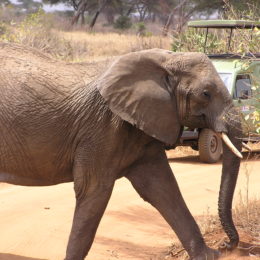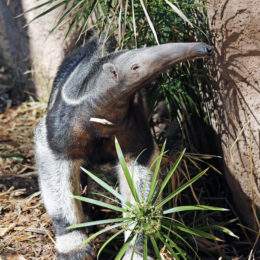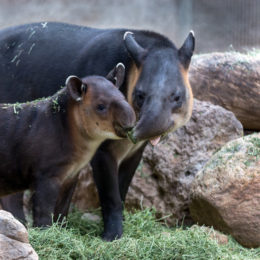Conservation Partners and Projects
At Reid Park Zoo we are actively involved with conservation programs around the world. With your help, we are able to address a wide range of issues that impact animals in the wild. Here are the projects we are working on with our colleagues now:
Tanzania Conservation Research Program
Reid Park Zoo has had a personal relationship with Charles and Lara Foley over the last decade. Their in-situ conservation efforts related to African elephants have been inspirational. Over the last few years, they have been working to create habitat corridors for elephants to move outside the park as they search for water and food. They have found new ways to collaborate with local people and create a community-based approach to protect the elephants. To date over 1 million acres of habitat around the Tarangire National Park have been protected.
Click here to learn more about how you can help protect wild elephants.
Anteaters and Highways Project
The largest remaining populations of giant anteaters live in the grasslands and forests of Brazil’s Cerrado habitat. This habitat is being disrupted due to rapid agricultural development and the building of roads. Giant anteaters are one of the animals that are most frequently involved in car accidents. The Anteaters and Highways project works to provide a better understanding as to why this is happening and works to prevent anteater roadway mortality. Follow them on Facebook .
Kids can learn more about how Zoo’s are helping conserve anteaters by listening to the story, “Why Did the Anteater Cross the Road.”
Baird’s Tapir Survival Alliance
The Baird’s Tapir Survival Alliance works to ensure the survival of the Baird’s tapir in the forest habitats they live in throughout South America. The main threats to the survival of Baird’s tapirs include unsustainable hunting, retaliatory killings for crop-raiding, habitat destruction, road development, and global climate change. Working in Mexico, Guatemala, Honduras, Nicaragua, Costa Rica, and Panama, the BTSA is working to reduce tapir poaching and develop conservation actions, such as patrols in areas of known tapir poaching, and environmental education in communities that coexist with tapirs. Follow them on Facebook. To learn more about the BTSA, please watch their newly released documentary.
Tiger Conservation Campaign
Worldwide, tigers are found in less than seven percent of their original range and are threatened by habitat loss and degradation, poaching, tiger-human conflict, loss of prey, and other factors. Four of nine subspecies have disappeared from the wild just in the past hundred years and the Amur, Sumatran, and Malayan tigers are all thought to number fewer than 500 individuals in the wild. Through the Association of Zoos and Aquariums’ Tiger Species Survival Plan’s Tiger Conservation Campaign, Reid Park Zoo is helping to protect Malayan tigers by providing funding to support anti-poaching efforts for both tigers and their prey.
Red Panda Network
Red Panda Network (RPN) is the world leader in protecting wild red pandas and their habitat. Their conservation programs occur in 50% of Nepal’s red panda range and covers over one million acres. this project uses integrated, landscape-level approach to conservation that is built on the support and participation of local communities. We work with community partners in 13 districts (of 23 red panda range districts) in Nepal with over 75 Community Forest User Groups in adopting sustainable forest management practices. Enjoy this video, narrated by Sir David Attenborough, to learn more about their award willing work.
University of Arizona – Biodiversity, connectivity, and impacts of anthropogenic barriers on vertebrate communities in protected areas of the southwest borderlands
This study will conduct vertebrate biodiversity surveys and assess the impacts of border-related disturbance on both sides of the US-Mexico border, including the Chiricahua National Monument. Few studies have directly monitored space used by vertebrates to understand how wildlife use natural corridors and respond to border-related disturbances and barriers; this information can be used to inform conservation on both sides of the border. During this study, black bears will be fitted with radio collars so that their movements can be tracked. Since black bears are large-bodied animals, they will be used as a model to assess animal movement and response to human activities. Reid Park Zoo is participating in this study by providing funding and assisting with bear health assessments while the bears are fitted with radio collars.
Protecting Native Wildlife
Reid Park Zoo supports the Humane Society of Southern Arizona’s efforts to provide shelter to domestic animals in need, minimizing the number of unwanted pets, sick and injured pets, and homeless pets, and providing educational opportunities in our community about proper animal care and ownership. Supporting this organization assists in protecting native wildlife by reducing the number of feral cats and dogs (domestic animals that are let loose into the wild) that could prey on native animals and spread disease.
Reid Park Zoo also supports the Tucson Wildlife Center, local wildlife rehabilitators, who care for injured, sick, distressed, or orphaned wild animals. Their goal is to rehabilitate animals so that they are able to survive on their own and then be released back into the wild. You can help them by learning more about what you should do if you suspect an animal needs your help. Tucson Wildlife Center’s Rescue FAQs.
SAFE Program – Saving Animals from Extinction
Reid Park Zoo has joined forces with fellow Association of Zoos and Aquariums facilities to help save animals from extinction. Each SAFE (Saving Animals from Extinction) program highlights a species that is in immediate need of assistance. By focusing the collective expertise within AZA-accredited zoos and aquariums, and empowering our massive audiences, we can achieve the goals of all of the SAFE programs. To learn more, please visit: https://www.aza.org/safe-species. Reid Park Zoo is partners with the following SAFE programs:



